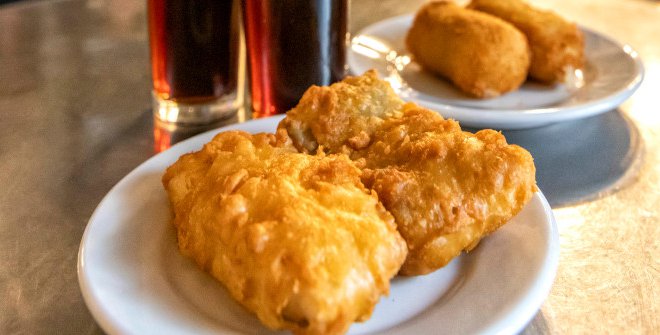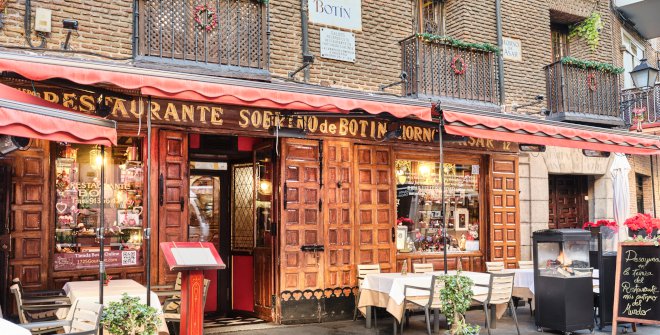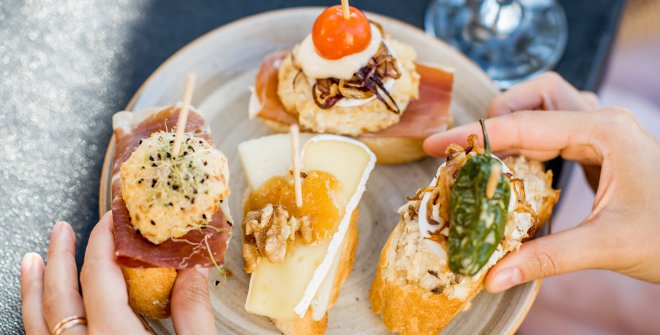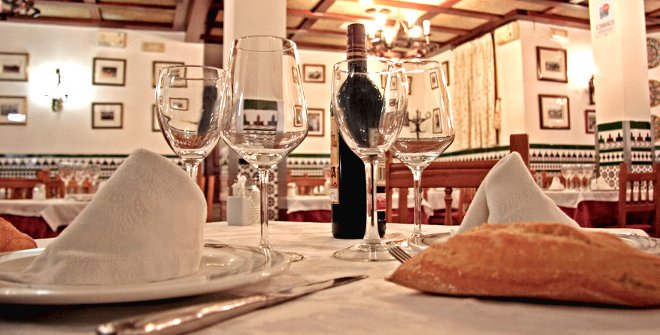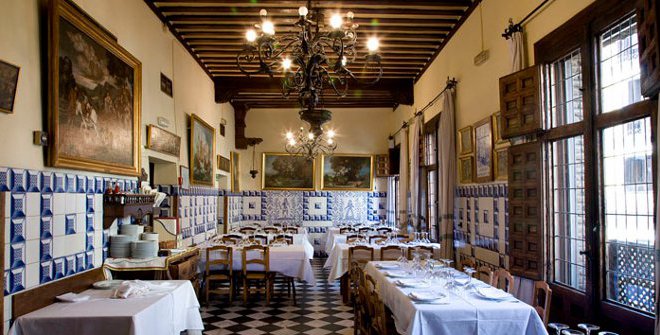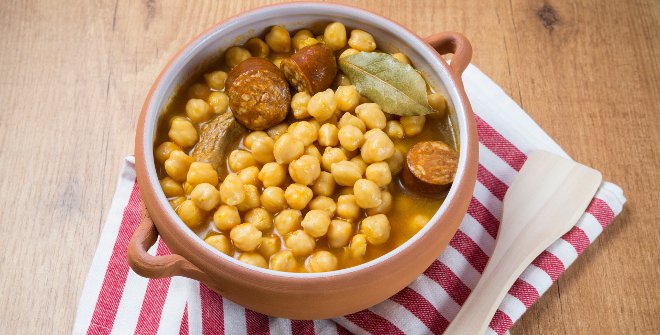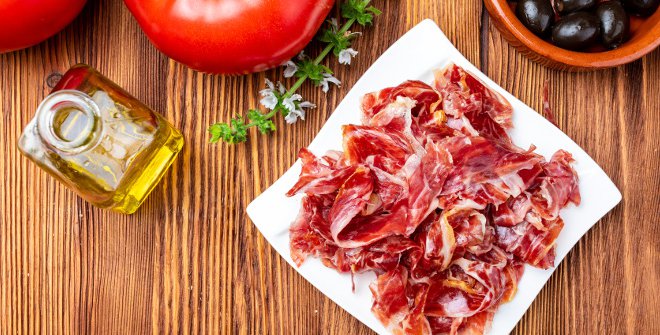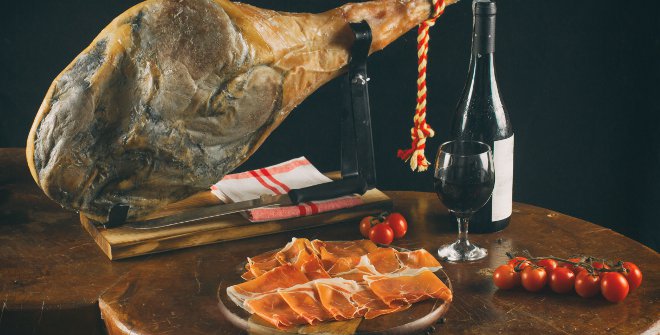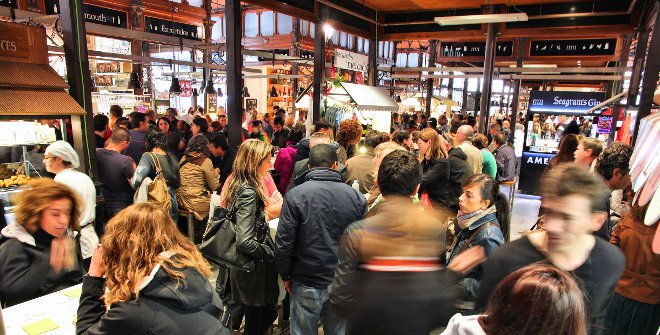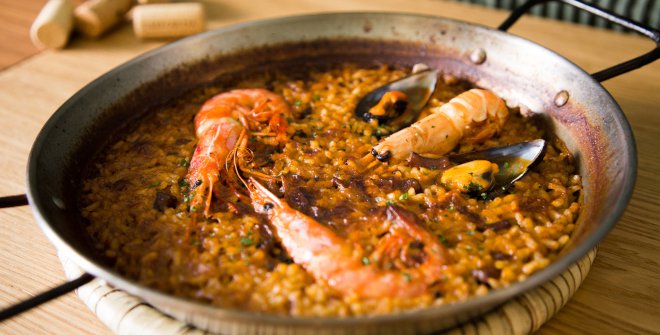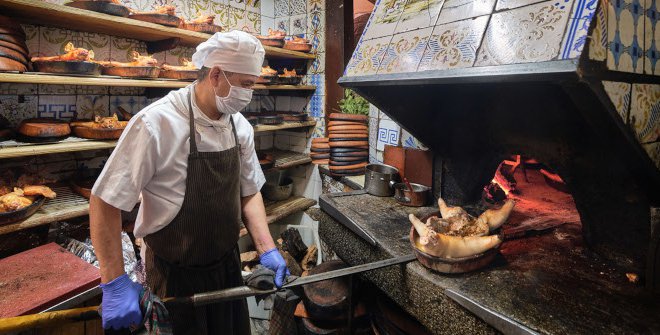The most traditional appetisers
Walk into almost any bar or taberna in Madrid and you’ll hear, “There’s some room at the back!” But once you’ve settled in, what should you order? To feel like a true Madrileño, be sure to try some of these classic Madrid bar dishes. Or perhaps all of them...they’re so yummy!
Published in esMADRIDmagazine in February 2024
Let’s be honest: you can’t feel like a true Madrileño if you haven’t spent time enjoying some beers and tapas with friends. But what’s the capital’s most traditional aperitivo (pre-lunch snack)? According to the Madrid Academy of Gastronomy, that honour goes to soldaditos de Pavía (cod fritters), more specifically, the ones served at Casa Labra (No. 12 Calle de Tetuán) since 1860. When General Pavía’s cavalrymen dissolved the Spanish Parliament on 3 January 1874, ending the First Republic, Madrid’s people associated the red tone of their dress coats with a pincho (small portion of food) served at this taberna: cod fritters wrapped in roasted red pepper. They no longer come with that adornment, but they’re very tasty; a classic—and irresistible—Madrid snack.
AN ORDER OF CROQUETTES!
The croquetas at the same restaurant, which is over 150 years old, are also iconic: its kitchen turns out over 1,000 a day. It’s impossible to find a bar in Madrid whose menu doesn’t include these little morsels of dough, which are made with a variety of minced ingredients held together by thick béchamel sauce, coated in egg and breadcrumbs, and fried in plenty of oil. They can be round or oval-shaped, depending on the chef. They’re almost the only speciality in some restaurants, like Casa Julio (No. 37 Calle de la Madera), a taberna in the Malasaña neighbourhood established in 1921 which became famous after the Irish band U2 chose it as the location for a photo shoot over 20 years ago. They serve croquettes made with black pudding and quince, spinach, raisins and Gorgonzola cheese…and of course, ham, which is the key ingredient in the ones Miguel García serves at the bar of Santerra (No. 56 Calle del General Pardiñas), which are lightly breaded yet crunchy on the outside and almost liquid on the inside. The creamy croquetas at Casa Mortero (No. 9 Calle de Zorrilla) are also spectacular, and its menu features another traditional appetiser: ensaladilla, or tuna and potato salad, which it makes with bluefin tuna and piparra peppers.

ENSALADILLA AND BOQUERONES
Most bars in Madrid no longer use the adjective rusa (“Russian”) to describe their ensaladilla, but it did originate in the country it was named after, where it was created by Franco-Belgian chef Lucien Olivier in 1860. The main ingredients are potato and mayonnaise, which holds together the rest of the contents (usually tuna and olives, although it can have anchovies, capers, peas, carrot and crab). We’ve been eating it in Spain since the late 19th century. For true ensaladilla lovers, we have a few recommendations: Moscatel, in El Pardo (No. 21 Avda. de la Guardia), which uses hand-cut bluefin tuna belly; Terracotta (No. 80 Calle de Velázquez), where it’s very creamy and has pickles, piparra peppers and bluefin tuna; Casa Felisa (No. 15 Calle de la Beneficencia), where it’s topped with a shrimp omelette; and Hermanos Vinagre (No. 58 Calle de Narváez), where its only ingredients are potatoes, tuna, mayonnaise and olives, and, in honour of its roots, it’s served in a matryoshka doll.

This bar, which also has branches at No. 17 Calle de Gravina and No. 26 Calle del Cardenal Cisneros, is a culinary mecca. It’s the perfect place to have a draught beer or the house vermouth, two drinks that go perfectly with boquerones (anchovies marinated in vinegar), which are seasoned with chopped garlic, a dollop of olive oil and fresh parsley. The dish is typical of southern Spain but is found all over Madrid, where it’s usually accompanied by chips—like at the taberna La Elisa (No. 42 Calle de Santa María)—or even by cured anchovies, which makes quite an interesting pairing.

WITH BRAVA SAUCE: FRIED POTATOES AND PIG’S EAR
Patatas bravas—diced fried potatoes topped with spicy sauce—is an authentic Spanish dish, a status confirmed by the UN in a book published in 2008. They should have been a bit more specific and said, without fear of equivocation, that it’s from Madrid. It was here that patatas bravas originated in the mid-19th century in the most humble of kitchens, before it began to feature on the menus of bars, some of which turned it into a truly tempting dish. One of them is Las Bravas (No. 3 Calle de Álvarez Gato), whose concave and convex mirrors appear in Valle-Inclán’s play Bohemian Lights. Its brava sauce, which is light and mild but very tasty, has been patented since 1960. So, how’s it made? With tomatoes, extra virgin olive oil, sweet paprika, hot paprika, salt, flour, garlic, ginger...plus their own secret ingredient. Secrecy also surrounds the sauce served over the potatoes at Docamar (No. 337 Calle de Alcalá). Since the 1960s, they’ve been turning out over 2,000 kilos of it per week; what a record! It’s poured on the large chunks of potato in front of the customer. Light and made with paprika, the sauce is traditional, but it has a bit of a kick. Another must is Taberna & Media (No. 30 Calle de Lope de Rueda), whose potatoes are crunchy on the outside and creamy on the inside. Here, the brava sauce is based on Canary Island mojo picón sauce. Spicy but not too hot, they don’t use tomato, instead, it’s made with La Vera paprika, garlic and cumin, with breadcrumbs added for texture.

You’ll have to head to the neighbourhood of Carabanchel to try one of Madrid’s most authentic tapas: minutejos, a sort of sandwich stuffed with sliced pig’s ear and spicy sauce. Naturally, it’s the house speciality at La Casa de los Minutejos (No. 19 Calle de Antonio Leyva), but there are other options if you want to enjoy some nice roast pig’s ear, which has a jelly-like texture and is sometimes served with garlic and parsley. You can’t go wrong at El Lince (No. 289 Calle del Príncipe de Vergara), where it’s topped with brava sauce, lime and Tajín seasoning; at KultO (No. 4 Calle de Ibiza), where it’s very crunchy and served with blackened habanero sauce; or at The Omar (Plaza del Carmen), where it’s in a sandwich.

THE MOST TRADITIONAL SANDWICH
Speaking of sandwiches, if there’s one that’s truly a classic in Madrid, it’s the fried calamari sandwich. Its origins are hard, if not impossible, to pinpoint. In the mid-19th century, the advent of the railway fostered the consumption of seafood in Madrid, and a significant number of people also arrived from Andalusia—where fish is typically battered—to open new tabernas. It was El Brillante (No. 8 Plaza del Emperador Carlos V), which opened opposite Atocha Station in the 1950s, that made the snack an almost ubiquitous item on Madrid’s menus. The traditional bar, which has a long zinc counter, serves up almost 2,000 of them a day.
It’s traditional to visit the area around Plaza Mayor at any time of year and go into one of the many bars which serve these sandwiches. Among them are Magerit (No. 22 Plaza Mayor), the first restaurant to set up outdoor seating in the square; Los Galayos (No. 5 Calle de Botoneras), which uses rustic ciabatta and calamari fried in olive oil; and La Campana (No. 6 Calle de Botoneras), where a serving of the big, heavily battered calamari rings can also be ordered separately.

TORTILLA, WITH OR WITHOUT ONION
Tortilla, or potato omelette, can also be eaten in a sandwich, but in Madrid it’s more traditional to order it as a pincho, a small portion normally served with some crusty bread. It can be thick or thin, runny or well-cooked, and—most importantly—with or without onion. There are countless ways to make it, but no one should leave Madrid without trying the tortilla at La Ardosa (No. 13 Calle de Colón) in the Malasaña neighbourhood. Established in 1892, its red façade makes it easy to recognise. Everyone orders the same thing here: tortilla, made with five medium-sized Mona Lisa potatoes, seven eggs, half a large onion, extra virgin olive oil and salt. It’s hard to choose the best tortilla in our city. For many, it’s found at Sylkar (No. 17 Calle de Espronceda), a bar that serves homely food in the Chamberí neighbourhood. Others like Taberna Pedraza (No. 4 Calle de Recoletos), which makes it tasty, runny and without onion, with the egg forming a soft shell around the potato, Juana La Loca (No. 4 Plaza de Puerta de Moros), where it’s made with caramelised onion, and Casa Dani, a famous bar in La Paz Market (No. 28 Calle de Ayala).

THAT’S NOT ALL...
We have two more suggestions for traditional light Madrid fare: the caracoles (snails) at Casa Amadeo-Los Caracoles (No. 18 Plaza de Cascorro) in El Rastro flea market, served in a sauce like no other that’s made with Iberian meats, and the gambas al ajillo (garlic prawns) at La Casa del Abuelo (No. 12 Calle de la Victoria), a century-old taberna which serves them in little clay pots, sizzling in oil and seasoned with garlic, cayenne pepper, fresh parsley…and lots of love!

